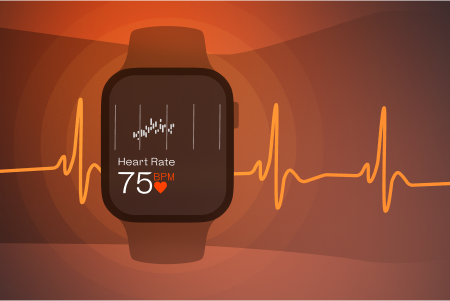
Measuring Resting Heart Rate
From manual pulse counts to the latest in app technology, dive into the transformative journey of heart rate monitoring

Your blood oxygen level indicates how much oxygen is in your blood. When you breathe, oxygen enters the bloodstream. Red blood cells then carry it throughout the body, fueling every cell and system, from the brain to the digestive tract. Maintaining the right level of blood oxygen saturation is essential for overall functioning and health. A low blood-oxygen level could signal a serious medical condition.
A doctor can measure your blood oxygen level with a blood test or a process called pulse oximetry. You can also perform pulse oximetry at home using a pulse oximeter. Usually, people touch these devices on a finger, toe, earlobe, or wrist, where capillary veins are close to the skin’s surface. The pulse oximeter shines infrared light through the tissue and measures the percentage of oxygen saturation in the blood, or the SpO2 level. Pulse oximetry isn’t as precise as a blood test, but it is quick, painless, and non-invasive. You can purchase pulse oximeter devices at most pharmacies and drugstores. Some smartwatches and fitness trackers also have pulse oximetry sensors.
The Minnesota Department of Health states a typical blood oxygen level is 95 percent or higher. People with chronic respiratory conditions, including asthma, sleep apnea, and lung disease, tend to have levels closer to 90 percent. Heart conditions, anemia, and some strong pain medications can also decrease blood oxygen levels, according to the Mayo Clinic. Although 88% might be a usual level for someone with COPD, generally, a blood oxygen level below 90% — a condition called hypoxemia — signals a need for medical attention.
Various conditions that affect the heart or lungs can affect blood oxygen levels, as can being at a high altitude. For many people, minor or moderate lifestyle changes can help to increase oxygen levels and improve overall well-being. Here are a few techniques to try.
Exercise is one of the best ways to increase oxygen levels in the blood. It might seem counterintuitive since you might experience shortness of breath during a vigorous routine. But as your breathing speeds up, you actually take in more oxygen. Physical activity also promotes circulation. Over time, exercise can also improve lung and heart health, further raising blood oxygen levels.
Being outdoors increases the amount of fresh air you consume and raises oxygen levels in the body. Spending time in green spaces is all the better, as plants and trees absorb carbon dioxide and release clean air into the atmosphere. If you’re not too keen on going outside on rainy days, think again – wet weather can improve air quality and boost the health benefits of being outdoors. Opening a window can improve indoor air quality and increase available oxygen when going outside isn’t feasible.
Get Welltory
for stress relief
Get Welltory
for stress relief
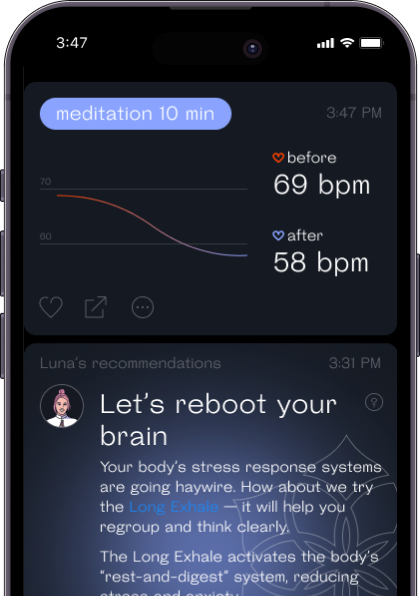
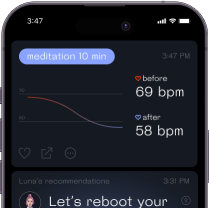

Deep, slow breathing opens the airways and allows the body to take in more oxygen. With time, intentional breathing practices can also improve lung capacity by helping the lungs work more effectively. Pursed lip breathing and deep belly breathing are two techniques experts frequently recommend to increase oxygen levels.
Pursed lip breathing may be easier for beginners. To do it, inhale slowly through the nose and purse your lips as if you were about to blow out a candle. Exhale very slowly through your pursed lips and repeat.
To practice deep breathing, or diaphragmatic breathing, first sit or lie down and relax your shoulders. Place one hand on your belly and the other on your chest. Inhale through the nose for two seconds, noticing as the air moves through your abdomen. Exhale for two seconds through pursed lips while pressing your stomach, and repeat.
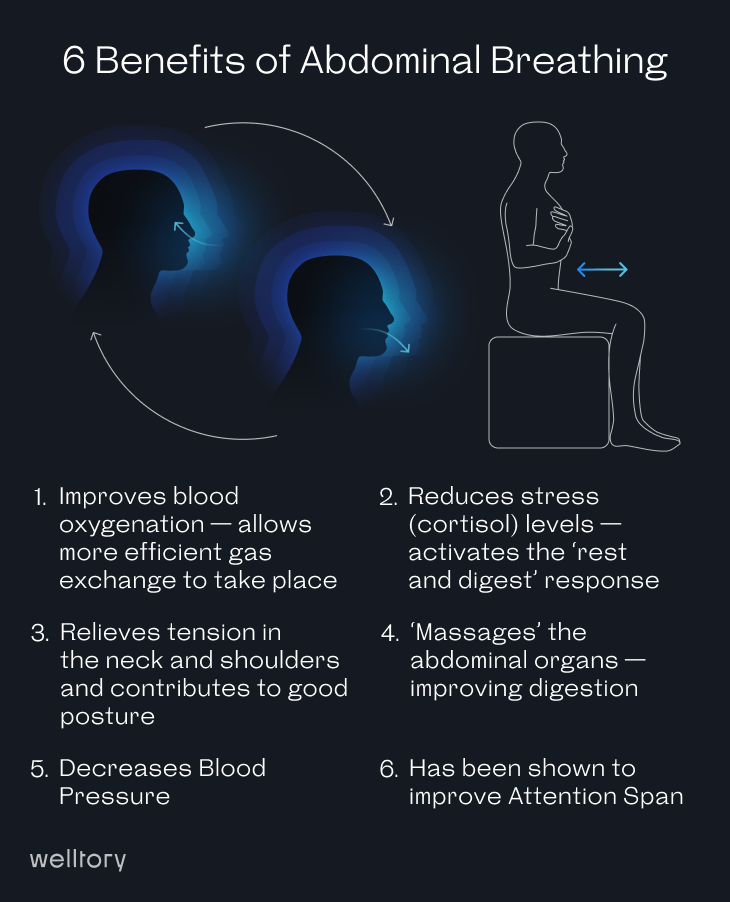
Through photosynthesis and respiration, plants take in carbon dioxide and release oxygen. This can replenish the oxygen supply in the surrounding environment, enabling you to take more in. Some of the best air-cleansing houseplants include the peace lily, spider plant, snake plant, Boston fern, bamboo palm, weeping fig, and English ivy.
Cigarettes contain carbon monoxide, which binds to hemoglobin in red blood cells and blocks oxygen from doing the same. This reduces the amount of available oxygen in the bloodstream.
For current smokers, quitting is one of the best ways to increase oxygen levels. Most people’s circulation significantly improves within two or three weeks of quitting. And within one to nine months, wheezing and shortness of breath – common side effects of smoking – diminishes as the lungs work more effectively. These factors combined can raise oxygen levels.
Iron is essential because it helps the body create hemoglobin, a protein that helps red blood cells carry oxygen through the body. If you don’t consume enough iron, the body can’t produce enough red blood cells, and your blood oxygen level will decrease. According to the FDA, most adults need 18mg per day.
Meat, seafood, and eggs are high in iron. So are several plants and plant-based foods such as beans; peas; tofu; dark, leafy greens like spinach and kale; fortified cereals, bread, and pasta; and dried fruits, like prunes and raisins.
Drinking water is crucial to maintaining circulation and helping nutrients, including oxygen, move through the body. If you don’t have enough water – dehydration – issues like hypotension and lactic acid buildup can occur and potentially affect your breathing ability. Drinking water also helps to thin the lungs’ mucus lining, preventing harmful buildups and enabling the lungs to work more effectively.
How much water you need depends on factors like your body composition, environment, and activity level. But most men need about 15.5 cups (3.7 liters) of fluid per day, and most women need around 11.5 cups (2.7 liters), according to the U.S. National Academies of Sciences, Engineering, and Medicine. Generally, about 20% of your daily intake will come from foods, including fruits and vegetables, while the rest will come from drinks.
Welltory can’t measure your blood oxygen levels. But it can provide valuable insights to help you make sense of your results, determine what factors affect your SpO2 levels, and track changes over time. Welltory also assesses SpO2 alongside other metrics, like heart rate variability (HRV). This provides a clearer, more complete picture of your health.
Before you take your SpO2 level with a pulse oximeter device, smartwatch, or fitness tracker, connect it to Apple Health, Google Fit, or Samsung Health. You can also enter your data manually into the aggregator. Then, go to Welltory and connect it with your wearable device, like Google Fit or Apple Health, and grant Welltory data access.
After taking your reading, you’ll find detailed charts in the Welltory app under the Health tab in My data.
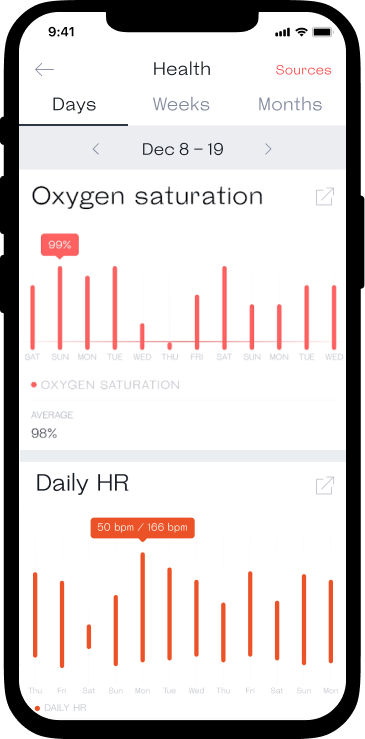
Your blood oxygen level is a crucial indicator of how well your lungs are functioning. It can also tell a lot about how different habits and circumstances – like exercise, diet, and environment — affect your overall health and well-being.
With Welltory and a wearable device, it’s easy to measure and track your SpO2 levels to ensure your body is operating optimally. If your levels are lower than you’d like and you’re wondering how to get more oxygen in your blood, there are several possibilities. As you go through the list above, use Welltory to keep an eye on how your SpO2 level changes (or not). If one technique isn’t working, try another instead. Finding an effective way to improve blood oxygen levels might take some trial and error. But if your blood oxygen levels are consistently low or drop significantly, talk to your doctor, as this could be a symptom or sign of a serious underlying condition.
Welltory Team, 15 Dec. 2022

From manual pulse counts to the latest in app technology, dive into the transformative journey of heart rate monitoring

Discover the intricate relationship between late-night eating and its impact on sleep duration and quality
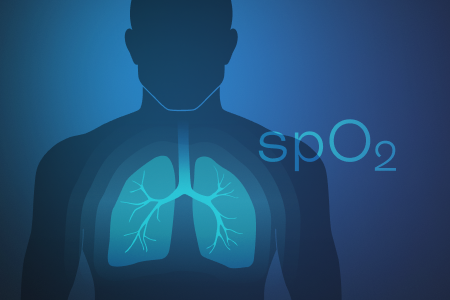
From boosting cognitive function to enhancing physical performance, discover the impact of blood oxygen levels on various aspects of health

The relationship between stress and productivity and how Welltory can help you plan better

Does sleeping burn any calories, should you exercise right before bed and how much do you need to sleep to burn a 1000 Cal

All you needed to know about headaches at night – types of nighttime headaches, their causes, possible treatment and how to avoid them.
 App Store
App Store
 Google Play
Google Play
 Huawei AppGallery
Huawei AppGallery
 Galaxy Store
Galaxy Store







